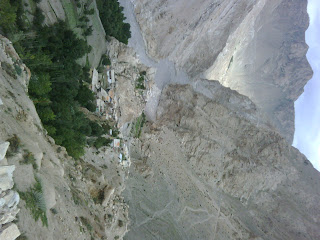

We're only here for one day, but that's a day longer than anywhere else we've been except Simla; it's a rest day, a day to chill and recover from the last 1500+ km before our final two days of riding. It also gives the team a chance to tot up the damage to the bikes over that distance. Although we're insured third party, we rode the Enfields on the understanding that we would pay for any damage we caused or major repairs that are needed. It's only fair that the bikes are presented to their next riders in the same condition that we ourselves received them. Some of us have had fairly major prangs, but the resilience of these bikes is amazing, with seemingly little more than a hammer, or handy roadside rock in some cases, they can be made roadworthy. Never-the-less we are expecting appropriate repair bills. As I said, it's only fair; fortunately parts and labour for Enfields are dirt cheap in comparison to your typical Japanese or European powered two wheeler.
Manali is known to some as the Goa of the North. Well I've never been to Goa so can't compare the two. But from what I've seen of Manali and heard about Goa I can understand the origin of the moniker. The old town is very laid back and has attracted a cornucopia of hippy types and for some strange reason a significant proportion are Israeli. Just why this area (we saw many on the road too) has attracted this particular nationality is puzzling. Perhaps it's grown as a destination like Spain did for the British in the 70's.
You can find houses like those seen in Nako in the old town, ie stone/wood construction with overhanging upper floors and integrated cow storage! That style seems popular in the less touched areas we've been to, but where economics allows, more western (and boring) straight walls are becoming dominant.
Lower down the valley is the "new" town. More commercial, it's like most bustling towns in India, full of sights and smells - some good, some bad - thriving enterprise, wonderful fresh cooked food, vegetable stalls full of colour, as are the clothes shops. Mixed into this fabric is the ever present decay of a country without universal waste disposal, although Manali is better than some I've seen - no, smelled! The altitude helps in that regard, as it's cooler at 2000m than say in a big city at lower altitude.
I've been giving some thought on what to wear for the final night party. The theme as I mentioned is "Indian" and who better than Gandhi himself to inspire me. So, I'm planning to make good use of the sheets at the Radisson and will need to learn how to tie a Dhoti before then. Others are buying off the peg or tailored outfits here, which is fair enough, but I don't wear shalwar kameez often enough back home to warrant having yet another one hanging unused in my closet.
Manali is also a base for many adventure types exploring Northern India. Surprise, surprise, Enfields are the chosen mount for those opting for two wheels, and these can be bought or hired at many places in Manali. Of course what you can't buy here is Alex, Steve, Colin, Doc Rob, Doc, Sarah, Billy, Nargis, Sam, Kamal, Lovely, the mechanics and anyone else in the Enduro team I've missed. Without these guys you're on your own. To some that is part of the adventure and I agree, but I came for the riding and the scenery, not to be stuck at the side of the road with a broken down bike. You get what you pay for.
Despite this I saw many guys negotiating prices and jumping on an Enfield to try it out. I felt a great temptation to shout out advice like: stay off the front brake or twist the throttle gently! But I didn't; two weeks in the saddle does not an Enfield instructor make.
I pity those brave souls that after a short test ride then decide on a merry jaunt to the Rotang Pass - that would certainly be character building, or in the worst case, character breaking. I'm sure many do it successfully, but having done it myself, I would not recommend it to anyone new to the Enfield or even Indian roads.
Today, I'm walking easily and feeling good, but the abrasion clots are beginning to itch. As the prayer flags were obviously not working I've taken them off the bike. Instead I've had a sign made which I will fit above the number plate: "keep your distance - I fall off suddenly" complete with a picture of a motorcycle and rider, with yellow helmet of course. No elephants!











































